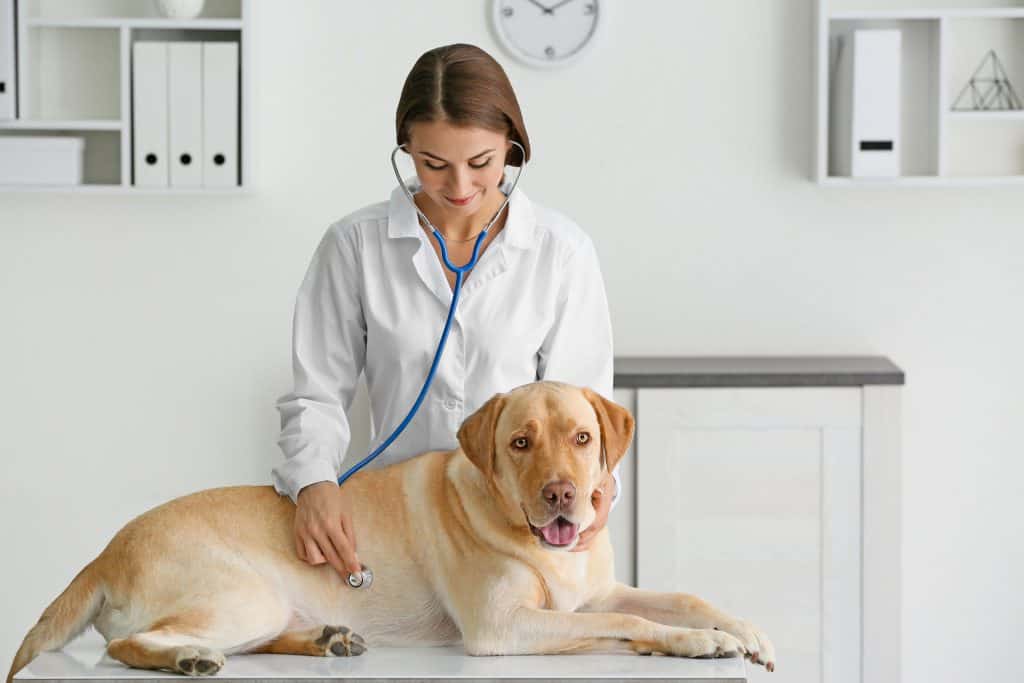
Generally speaking, The Labrador Retriever is a healthy dog breed. This is because Labradors are more genetically diverse than other breeds. However, they can still be susceptible to suffering from inherited canine health issues. Some ailments are generally caused by a combination of the genes inherited from their parents, while others are caused by environmental factors. These environmental factors can range from their diet to their lack of exercise and hormonal issues. Here are some of the most common health issues your lab might face:

Joint problems:
Hip dysplasia:
Hip dysplasia in Labradors is a common ailment. It is a result of the abnormal formation of the hip socket causing deterioration of a lab’s hip which can also lead to canine arthritis of the joints and can also result in a loss of function. Usually, this doesn’t become an issue for dogs until they reach their middle or later years. However, in some cases, this ailment can develop as early as 5 months.
If you are looking for a Labrador puppy, make sure you request the hip scores of its parents. Every responsible breeder should be aware of these scores. The hip score is found by examining an x-ray of a dog that is over one year old. Each hip is assigned a score of 0-53 and combined the total hip score ranges from 0-106.
Lower scores that are even on each side are preferred. According to the BVA/KC, a Labrador’s average hip score is to be 9, and it is ideal to have parents that are around or below this hip average.
Elbow dysplasia:
Just like hip dysplasia, minus the abnormal formation and deterioration, this occurs at the elbow joint. A clinical display of the signs of elbow dysplasia is often seen between 4 and 10 months of age. Although for better prevention, make sure you get your puppy checked as later occurrences can also take place.
The treatment for elbow dysplasia involves the surgical removal of certain bone fragments and cartilage followed by weeks of physical therapy during recovery.
The elbow grade gives a score between 0 and 3 based on an x-ray examination for elbow dysplasia in dogs. According to the British veterinary association(BVA), Labrador retrievers that are used for breeding purposes should have an elbow grade of 0. This is something that you should be aware of when you are looking for a puppy to bring home.

Obesity can cause Labrador health issues:
Labradors are famously known for rapid eating which can also result in dangerous gastric distention. In dogs, this is also known as bloat. This is a huge health problem in Labradors, and you should be cautioned about it.
Healthy labs weigh anywhere from 55 to 75 pounds, and a fat lab can top 100 pounds. Extra weight can have a serious impact on your Labrador’s health and life expectancy. Obesity dramatically increases the chances of heart and liver disease, joint inflammation and arthritis, skeletal problems, metabolic and respiratory diseases along with lowered resistance to disease in general.
If you believe that your lab is overweight then begin by consulting with your vet to develop an appropriate feeding and exercise regime. To prevent your lab from becoming overweight start off by making sure that he or she gets regular exercise daily.
Exercise activities that you can enjoy with your dog include playing fetch, letting your Labrador run, and taking an agility class together. Make sure you come up with a routine to help your dog shape up and increase his/her mental alertness at the same time.
Bloat or Gastric dilatation-volvulus:
GDV or Gastric dilatation-volvulus is a life-threatening condition that primarily affects large and deep-chested dog breeds. Commonly known as bloat or torsion, this condition occurs when your pet’s stomach fills with fluid, food, or gas. When this happens, the stomach expands against other organs, and this may result in a lack of blood flow to the heart or stomach lining, difficulty breathing, and a tear in the stomach wall.
When this happens, they might even rotate or twist. Due to this, a dog might even be unable to belch or vomit to rid himself of excess air. This may cause the blood flow to the heart to become impeded, and blood pressure levels may drop which can send the animal into shock or even death.
The exact cause of gastric torsion in dogs is unknown. The risk factors are often higher for canine bloat symptoms if your dog has a first relative that has previously suffered from Gastric Dilatation-Volvulus (GDV).
Eye conditions:
There are several reasons why your dog may develop cataracts. The most common cause is genetics in your dog. Dogs that are diabetic are especially at risk of developing cataracts. Other causes include diseases, nutritional disorders from puppyhood, eye injury, or infection.
You should contact your vet immediately if you notice any changes in your dog’s eyes or if you think that your dog’s vision is impaired or has deteriorated. The most common signs of cataracts include a bluish, grey, or white layer in the eye, a sudden reluctance to climb stairs or jump, clumsiness, eye irritation, and excessive rubbing or scratching of the eyes.
To prevent the development of cataracts, you must monitor your dog’s eye health regularly. Make sure you take him/her to the vet frequently to make sure that your dog’s health overall is not deteriorating.
PRA- Progressive Retinal Atrophy or blindness:
Progressive retinal atrophy in dogs is a blanket term used to describe a variety of diseases that cause retinal degeneration that leads to canine blindness.
The most common PRA type in Labradors is usually progressive rod-cone degeneration or PRCD when the rod cells in your dog’s eye have a mutation that eventually causes them to die. This can occur as early as 1 year or may develop later between the ages of 3 and 5.
There are many signs to look out for, but the most common ones include the eye becoming cloudy and changes in their behavior. Most eye diseases are passed from parent to offspring. So, you should be sure to review and conduct a recent eye exam certification of the parents before you adopt a Labrador pup.

Other minor Labrador health issues:
Ear infections:
Another Labrador health-related issue, ear infections are common for Labradors due to the intrinsic structure and make of their ear. The only effective way to manage and prevent ear infections in your dog is to ensure that the ears are dry after bathing. Secondly, you should regularly check your dogs’ ears for any abnormal discharge, odor, and/or redness. Common behaviors of dogs with an ear infection also include head shaking and pawing or rubbing of the ears. For this reason, routine cleaning with a gentle dog-approved ear cleaner may be very necessary to reduce the frequency of any recurrent ear infections in dogs.
Limber-tail syndrome:
This condition usually occurs after your dog takes a swim, after a heavy hunting day, or even after a cold bath. Generally, this syndrome heals itself after a week or so. However, if it persists make sure you consult a vet as soon as possible.
How To Prevent Health Issues in Labradors
Diet and regular exercise:
Exercising your lab regularly is essential. These dogs have a lot of energy and hence require frequent exercise. Play different games such as fetch and spend time outside daily. Make sure to consult your vet regularly and keep a diet plan that suits your dog. Whatever suits your dog is the best solution, and your vet’s consultation should always be present.
Vet visits and recommended health tests:
Regular visits to your local vet are necessary for your dog. Make sure you also know about all the important health tests that your dog needs, so you are aware of the internal health of your dog. Also, make sure you have pet health insurance for your dog if you want to avoid the abrupt expenses, caused by health issues that may affect your dog.
All in all, to prevent any such issues in your Labrador make sure you regularly consult your vet and conduct tests and be aware of your buddy’s health so you can prevent any further concerns.

Related post: Raising a Healthy Labrador Puppy
DNA Testing For Dogs
DNA testing can help you discover your dog’s ancestry, find out about your dog’s breed composition, and even find your dog’s canine relative. Testing your pet’s DNA can also be very useful for keeping your furry friend healthy by detecting genetic risks for potential health problems. DNA Tests can also find hereditary conditions that can affect your dog’s health in the future. This information can help your Veterinarian to provide adequate preemptive healthcare.
Click Here To Find The Best Pet Insurance for Labrador Retrievers

